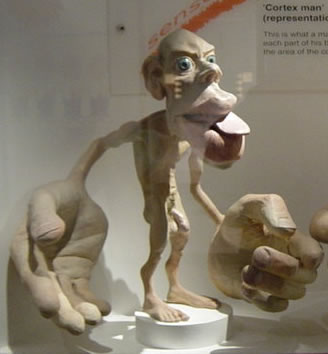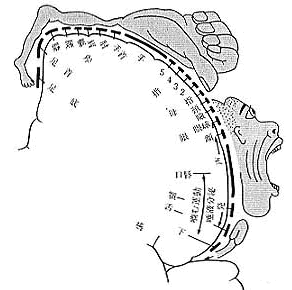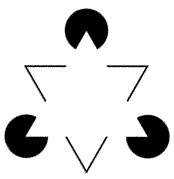 |
Hippocampus |
Cat: SCIPub: 2002#:0613b |
Yuji Ikegaya & Sigesato Itoi |
06424u/18214r |
Title
Hippocampus
海馬
Subtitle
Brain never get tired
脳は疲れない
Author
Yuji Ikegaya & Sigesato Itoi
池谷裕二・糸井重里
Published
2002
2002年
Index
Tag
; 100B neurons; Acetylcholine; Alzheimer; Amygdala; Anatomy of brain; Apotosis; Area of God; Battle against boredom; Cannot sustain viewpoint; Capgras delusion; Consistency & ego; Consumes 20-30% energy; Deceive hippocampus; Declarative(semantic/episodic); Dementia; Epitome of life; Failure teaches; Indifatigable; Lots of feelings; Hippocampus; Homunculus; Manager of memory; New viewpoint; Plasticity & stability; Reminiscence; Saving & processing; ;
Why?
- 31st year spirited doctor of pharmacy of Univ. of Tokyo writes
in an easy dialogue style with S. Itoi, a famous copywriter about
the mystery of hippocampus: an organ of managing memory in a brain.
- >Top It seems that hippocampus functions as manger of memory, while
amygdala gives criteria of emotions: interests, likes and dislikes.
- I hope my own amygdala gives me criterion of interest to know
about the function of brain.
- 31歳の気鋭の東大薬学博士が、コピーライトー糸井氏との対話形式で、脳内の記憶管理器官である海馬の神秘について語っている。
- 蓋し、海馬は記憶の管理人として機能し、扁桃体は興味や好き嫌いなどの感情の基準を与える。
- 私自身の扁桃体が脳の機能のついて興味の基準を与えてくれることを期待する。
Summary
要約
>Top 0. Introduction:

0. 序:
- Anatomy of brain:
- cerebrum: 大脳
- frontal lobe: 前頭葉
- parietal lobe: 頭頂葉
- occipital lobe: 後頭葉
- temporal lobe: 側頭葉
- cerebellum: 小脳
- spinal cord: 脊髄
- medulla oblongata: 延髄
- hippocampus: 海馬
- amygdala: 扁桃体
- caudate nucleus: 尾状核
- nucleus accumbens: 側坐核
- Activated situation of brain is changeable. Therefore, it is better
to keep to maintain such situation as long as possible.
- Sharpness or dullness of brain is a kind of a process, which could
be changeable according to the use of it.
>Top 1. Fuse wire of brain:
- Scientifically, fogettery doesn't relate to aging.
- Drawing by hand is useful to memorize. A process of drawing blows
up associate memory and assists to memorize through actual visualization
of the image.


- >Top <Above left>: Cortex man "Homunculus":
how much of the cortex relates to each part of the body with big
and long thumb and abnormally big face and tongue. Thus size of
parts of the body corresponds to areas of motor area of cerebral
cortex.
- <Above right> Sensor area map in (Rasmussen and Penfield,
1947)
- Thus, stereotyped observation with less surprise and impulse
may feel ourselves having a weak memory. It is important to
maintain freshness in observing our surroundings.
- Good and bad relate very much to likes and dislikes. Because
hippocampus and amygdala closely communicates each other; considering
favorable information as necessary one.
- To our surprise, so-called ranking people tend to be chatterers.
Speak in parables also related such associative memory.
- >Top Brain consumes 20-30% of total energy which a human absorbs, but
it is said only 2% of total capacity of brain is used. There is
a kind of stopper in our brain. There are two ways in proceeding;
to detach a stopper, or to extend the ability to proceed.
- When sleeping, we make 10 pieces of glucose, and destroy them
all. But when needed, we make 20 and destroy 5, whose mechanism
is easier to make 15 pieces of glucose from zero.
- Brain cannot endure nonstimulating.
- >Top Brain after 30 years old can behave differently, showing unique
ability of discovering connections or detective powers. 30th birthday
is an epitome of human life.
- Having a good taste would be more important than having a good
IQ or muscle.
1. 脳の導火線:
- 年を取ったから物忘れをするのは科学的に間違い。
- 描くことは記憶に役立つ。連想を膨らませ、具体的なイメージの形にすることで記憶を助ける。
- <左側の左図>
ホムンクルス:体の各部位の大きさは、大脳皮質運動野の相当領域の面積に対応。親指は大きく長く、顔や舌も異常に大きい。
- <左側の右図>
人の一次運動野における体部位局在の地図 (ラスムッセン&ペンフィールド、1947)
- 驚きや刺激が少なくマンネリ化して見ると記憶力が落ちたような錯覚を抱く。周囲を新鮮に見ていられるがが重要。
- 善悪は好き嫌いに大いに関係。
- 一流の人は意外とおしゃべり。またたとえ話もこの連想記憶に関係。
- 脳は、人の吸収するエネルギーの20-30%を消費しているが、それでも脳の能力は全体の2%しか使われていないという。脳にはある種のストッパーがある。前に進む力を伸ばすには2つの方法がある。即ちストッパーをはずすのか、前に進む力を伸ばすのか。
- 寝ている時は、ブドウ糖は10個作り10個壊す。必要な時は、20個作り5個壊す。この方法は、ゼロから15個作るよりも容易である。
- 脳は無刺激に耐えられない。
- 30代以降の脳は独特の働きをする。つながりを発見する能力や推理力を発揮する。30歳の誕生日は人生の縮図。
- センスが良いことはIQや筋肉が良いことより重要。
- >Top Brain has 100 billion neurons, but 98% of which are sleeping.
Neural circuit look like a city map connected traffic systems with
roads and cables.
- Energy for brain is glucose into which carbohydrate is discomposed.
- Each neuron ceases to exist every second, but still there are
much more surviving neurons during whole life.
- Brain of a mouse has comparatively bigger cerebellum than human.
Relatively the biggest one is bird because of its excellent motor
neurons.
- Human brain has the biggest visual cortex in brain (frontal
lobe), which shows how depends on ability of sight.
- >Top Brain is indefatigable. It is eyes which are fatigued. It is better
to walk around thinking the same thing when you become tired.
- It is better to break off at partway of the job rather than
at a good place to leave off.
- Brain's activity is mostly unconscious movement.
 Brain cannot sustain one definite viewpoint for a long time: It
may get tired or cannot continue.
Brain cannot sustain one definite viewpoint for a long time: It
may get tired or cannot continue.
- It may erase something if you order information too much.
- The first time experience will mostly smarten people; routine
working will not reorganize neuron network.
- Brain
tends to indulge in wishful or accommodating thinking; "fastened
physiology"?
- >Top <Kanizsa illusion> Brain recognizes invisible triangle.
- 脳には、1000億もの神経細胞があるがその98%は眠っている。神経回路は道路や電線を張り巡らせた交通システムを持つ都市のようである。
- 脳のエネルギーはブドウ糖で、それは炭水化物が分解されたもの。
- 各々の細胞は毎秒1個死滅するが、人生を通じてはるかに多くの細胞が生き残る。
- マウスの脳は相対的に小脳が大きい。相対比較で最大の小脳を持つのは鳥である。素晴らしい運動神経をもつから。
- 人間の脳 (前頭葉) は最大の視覚野を持つ。視力に依存しているから
- 脳は疲れない。疲れるのは目。疲れたら同じことを考えながら歩き回るのも一案。
- 区切りの良い所より、途中で仕事を中断する方がよい。
- 脳の働きのほとんどは無意識の動き。
- 脳は一つの視点を持続できない。飽きるのか続けられないのか
- 情報を整理し過ぎると消えてしまう。
- 初めての経験が一番鍛えられる。
- 脳は:脳は思い込み思考の傾向がある。いわゆる縛られている生理。
- <左図>カニッツアの三角形:脳は見えない三角形をあると思い込む。
>Top 2. Hippocampus increases:
- Function of brain:
In short, it is two: saving and processing of information. Saving
of information is memory, which is more important than processing.
Without memory human cannot speak at all.
- Episodic memory increases exponentially: 2^4=16, ... 2^10=1024
... 2^20=million
- Plasticity: could be wound or distortion
Hippocampus is the most plastic area in a brain.
- >Top Cf: Category of memory:
- Short-term memory:
- Long-term memory:
1) Declarative memory (Semantic memory and Episodic memory),
and 2) Non-declarative memory
- >Top Hippocampus:
- neurons increase only here.
- manufacturing facility of memory, judging use or disuse of information
like a sieve. Memory itself is stored in other area of brain.
- size of a little finger (1cm x 5cm)
- select few neurons (10 million) out of total 100B.
- Without this, memory cannot sustain longer than 5 minutes.
- Without this, concept of time disappears.
- short-term memory: Human can be concurrently conscious of about
7 events (magic number seven)
- >Top Amygdala:
- neurons do not increase here.
- size of a nail of thumb.
- >Top Without this, human can memorize but cannot have any emotion. (Capgras delusion: a psychiatric disorder, holding close family has been replaced by an identical impostor.)
- Such patient feels even a parent as an alike stranger.
- Such patient does not feel any fear.
- >Top Brain tends to make fairy story to maintain consistency and ego.
- Unconscious potion of brain is a liar.
- Number of neurons:
Even hippocampus dwindles in number if it is not used. If hippocampus
develops, it can proceed concurrently more information. The criterion
of memory is weather it is necessary for survival.
- >Top To memorize is to deceive hippocampus by convincing it is necessary
for survival.
- Amygdala, located near hippocampus judges cup of tea.
- Neurons of hippocampus changes every several months, probably
because it is not the saving area of memory.
- Neurons of other area of brain never change; if they are changed,
which makes totally different person.
- Lots of feelings of delight, anger, sorrow & pleasure are
effective to increase capacity of hippocampus.
- Capacity of hippocampus may change in several days according
to stimulation.
- Send the precious child on a trip:
- Information of space is the most simulative to hippocampus.
- >Top Creativeness is challenge to brain as well as battle against boredom.
Because the brain tends to keep stabilized viewpoint.
- Hippocampus can adopt new environment, eliminating stress.
- Assumption that this were other's worries is the key to solve
worries.
2. 海馬は増える:
- 脳の機能:
機能は煎じ詰めると2つ。情報の保存と情報の処理である。前者は後者より重要。記憶がなければ話すことはできない。
- エピソード記憶はベキ乗で増加
- 可塑性:傷かそれとも変形か
海馬は脳の中でも最も可塑性の高い部位
- 注): 記憶の種類:
- 短期記憶:
- 長期記憶:
1) 陳述記憶 (意味記憶とエピソード記憶)および 2) 非陳述記憶
- 海馬:
- 神経細胞は、ここだけは増加する。
- 海馬は記憶製造工場。情報の要不要をふるいのように判断する。
- 小指サイズ (1cm x 5cm)
- 脳全体1000億中の少数精鋭の神経細胞 (10百万)
- 海馬がなくなると記憶が5分以上持続しない。
- 短期記憶: 人は同時に7つ位だけ意識できる (マジック数7という)
- 扁桃体:
- ここの神経細胞は増えない。
- サイズは親指の爪程度。
- 扁桃体がなくなると、記憶はできるが感情はなくなる。 (カプグラ症候群)
- その患者は、親を見てもそっくりな他人と感じる。
- その患者には恐怖心がなくなる。
- 脳は整合性や自我を保つために作り話をする傾向がある。
- 脳の無意識の部分は嘘つきである。
- 神経細胞の数:
海馬も使わないと数がしぼむ。記憶の基準は生存に必要かどうか。
- 記憶するためには如何に海馬をだますか。
- 隣にある扁桃体は好きなものを判断する。
- 海馬の神経細胞は数ヶ月毎に入れ替わる。記憶する場所でないためか。
- 脳の他の部位では入れ替わらない。もし入れ替わると全くの他人になってしまう。
- 喜怒哀楽の多くの感情は、海馬の能力増強に効果的である
- 海馬の能力は、刺激によって数日で変化する。
- 可愛い子には旅をさせよ:
- 空間情報が海馬にとって最も刺激的である
- 創造力は脳への挑戦であり、退屈との闘い。脳は安定した見方をしたがる傾向あり
- 海馬は新たな環境に適用し、ストレスを除去する。
- これは他人の悩みと仮定することが悩み解決のコツである。
>Top 3. Effective medicine
for brain:
- Medicine for Memory loss:
- Synapse which is a cross-point of neural network has the most
plasticity ("synaptic plasticity")
- Such medicine makes synapse no be able to change plasticity;
traffic of information cannot change.
- medicine for Memory increase:
- Other medicine makes synapse to increase synaptic plasticity.
- One of these is DHA (Docosahexaenoic acid) often found in
fish oil. (Small amounts are made internally through α-linolenic
acid)
- Korean ginseng, Saffron (Crocus sativus), ...
- Medicine for Can-do sprit:
- Necleus accumbens is
the place to emit can-do spirit.
- Size is about a seed of an apple.
- The neuron of necleus accumbens is activated by giving an
impact. This means we must start anyway without drive. (Working
excitation?)
- >Top Neurotransmitter called acetylcholine stimulated
synapse.
- Alzheimer disease decrease such acetylcholine, showing less
get-up-to-go situation.
- Ingredients which suppress emit of acetylcholine in a medicine
for colds: diphenhydramine
- Circadian rhythm:
- Hippocampus make dream rearranging fragments of memories till
now
- At least six hours needed for reorganizing information. Thus
sleep less 6 hours become inefficient for brain's activity.
- Sleep shuts out external information, rearranging information
inside the brain. If sleep is not allowed, hallucination appears.
- >Top Reminiscence:
- Retention of memory is improved after a certain time passed.
- Preparatory works before sleep is also effective, avoiding
suppressor of acetylcholine.
- Antioxidant has antiaging effects.
- Oxidization is equal to corruption.
- >Top Dementia:
- A disease caused by too much death of neurons.
- Remedy for dementia: 1) boost plasticity of survived neurons,
2) life-prolonging of survived neurons, such as N-acetylcysteine
- >Top Duration of drive:
- Self-bonus and tiny goal
- Utilization of primary effect and terminal effect.
- "Failure teaches success": Many mistakes
are effective to avoid the future similar mistakes.
- Clear thinking by taking glucose and flavor of coffee.
- Amygdala is responsive to life crisis; coldness, hunger, sexiness,
etc.
3. 脳に効く薬:
- 記憶力減退の薬:
- シナプス (神経網の交差点)が最も可塑性に富む (シナプス可塑性)
- この薬はシナプスが可塑性を変化できなくなる。いわば情報の交通量を変化させられなくなる。
- 記憶力増強の薬:
- もう一つの薬はシナプス可塑性を増加させる。
- その一つはDHA (ドコサヘキサヘン酸)
(少量はα-リノレン酸経由で体内で作られる)
- 茯苓、朝鮮人参、サフラン、...
- やる気を出す薬:
- 側坐核がやる気を出す場所である。
- サイズはリンゴの種程度である。
- 側坐核の神経細胞は刺激が与えられて活性化する (作業興奮)
- アセチルコリンという神経伝達物質がシナプスを刺激する。
- アルツハイマー病はこのアセチルコリンが減少し、覇気を感じない状態になる。
- 風邪薬中のアセチルコリン抑制成分:ジフェンヒドラミン、スポコラミンなど
- サーカディアンリズム(概日リズム):
- 海馬は今までの記憶の断片から夢を再編する。
- 情報の整理に最低6時間位は必要。つまり6時間以下の睡眠は、脳の活動低下を招く。
- 睡眠は外界情報をシャットアウトして、脳内情報を再整理する。
- レミニセンス (追憶) :
- 一定時間後、むしろ記憶保持が改善される現象。
- 睡眠前の準備作業は有効、但しアセチルコリン抑制剤は飲まない。
- 酸化防止剤は老化防止効果あり:
- 酸化は腐敗である。
- 痴呆症:
- 神経細胞の過剰な死滅による病気
- 痴呆回復:1) 生存細胞の可塑性を高める、2) 生存細胞の延命策;Nアセチルシツテイン
- やる気の持続:
- 自己への報酬、小さな目標
- 初頭効果と終末効果の利用
- 失敗は成功のもと。多くの失敗は将来の同様の失敗を防ぐために有効
- ブドウ糖や珈琲の香りによる明晰な思考
- 扁桃体は生命の危機状況に敏感に反応、寒さや空腹など
>Top 4. Excess makes
genius:
- Apotosis:
- Neurons die fast in younger age. Neurons connected with useless
network die fast.
- Receptor has the initiative (in hippocampus):
- Neuron-A (addresser) tries to connect with Neuron-B (receptor)
- If there are two Neuron-B's near by, Neuron-A tends to connect
both B's
- After A and B have connected, if another A approached, the
connection will be depended on B's initiative.
- Creativity is a kind of technology. Human recognition including
sensitivity is made of combination of memory.
- A neuron responsive to a carrot:
- The numbers of such responsive neurons are at most several
millions.
- Common point of such responsive neurons are unique pattern
of pictures. Combination of several pattern recognizing neurons
can recognize particular object such as carrot, pineapple, ball,
tabby cat, etc.
- >Top Rigidity or stubbornness make bad brain:
- To add new viewpoint is essential.
- To create denser network with versatile recognition is important
- To become stubborn means to abandon the right of plasticity.
- To enjoy factor of uncertainty is useful.
- Games under monopoly:
- Mechanism of connection: to increase traffic to a certain
direction with minimizing traffic to other directions.
- Making a contrast with plus and minus factors.
- >Top Envy may be derived from the situation of dilemma where potentiality
of plasticity could not undertake.
- Balance of plasticity and stability is important.
- Discovery of connection or association.
4. やりすぎが天才を作る:
- アポトーシス:
- 神経細胞は若い頃早く死ぬ。役立たないネットワークと接続した細胞は早く死ぬ。
- 受け手が主導権:
- 神経細胞A(発信者) は神経細胞B(受信者) と接続しようとする。
- もし2つの神経細胞Bが近くにあれば、Aは両方のBと接続しようとする。
- AとBとが接続後、もう一つのAが近づいても接続するかはBに主導権がある。
- 創造力は技術の一種である。人間の認識は、感性も含めて記憶の組合せからできている。
- 人参に反応する神経細胞:
- このように反応する神経細胞の数はせいぜい数百万
- これらの反応する神経細胞の共通点は特異な図形。いくつかのパターン認識神経細胞の組合せが特定物質を認識できる。人参、パイナップル、ボール、トラ猫など
- 頑固さは頭を悪くする:
- 新しい視点を追加することが重要。
- 認識を豊富にしてネットワークを密にすることが重要。
- 頑固になることは可塑性の権利を放棄することになる。
- 不確定な要素を楽しむことが重要。
- 妬みとは、可塑性というポテンシャルを持ちながらそれを発揮でないジレンマの状態。
- 可塑性と安定性のバランスが重要。
- つながりの発見:
>Top 5. Journey to hippocampus:
- Sprit of hippocampus:
- Ingest accident or incident, then change the idea.
- Causing misunderstanding may be being attractive.
- Doubt on having clear target or grounds:
- It won't be bad to have neither clear target nor grounds to
do in the future.
- Object is not the only one, and truth not the only one.
- >Top Brain has an area to make God:
- There is an area where one could see God is an upper part of
left temporal lobe; could be called "area of God (or, God spot)." It
is not natural to deny the existence of God from the structure
of brain.
- epilepsy disease occurs in trouble near this area.
5. 海馬の旅:
- 海馬の精神:
- 偶然や事故を取り込んでは考えを変えていく。
- 誤解を与えることは魅力的であること。
- 明確な目標や根拠を持つことの疑問:
- 将来の明確な目標も根拠持たないことは、悪くはない。
- 目標も一つだけでなく、真実も一つとは限らないから。
- 脳には宗教を作る領域がある。
- 左の側頭葉の上の部分に神様が見える領域がある。神の領域ともいうべき場所。神の存在を否定することは脳の構造から自然ではない。
- てんかん病はこの領域の近くのトラブルによって生じる。
Comment
- This is a quite unique book which describe the latest explanation
of brain's function through the form of dialogue between specialist
and non-specialist of physiology.
- This unique dialogue format may be fit and resemble to the function
of brain itself; thus it could produce easy-to-read clear description
about hippocampus.
- We'd learn more about functions of morphine in the brain:
- (as stimulant): Dopamine, Noradrenaline
- (as suppressor):β-Endorphin
- これは脳の機能に関する最新の状況を、生理学の専門家と非専門家による対話形式で記述したユニークな本である。
- このユニークな対話形式は、脳自体の機能に適合しそれに似ているのかもしれない。だから海馬に関してかくも読みやすく明快が表現が可能になったのだろうか。
- 脳内モルヒネの機能に関してはもっと知りたい
- 興奮剤として:ドーパミン、ノルアドレナリン
- 抑制剤として:β-エンドルフィン
Title |
Hippocampus |
海馬 |
|---|---|---|
Subtitle |
Brain never get tired | 脳は疲れない |
Author |
Yuji Ikegaya & Sigesato Itoi | 池谷裕二・糸井重里 |
Published |
2002 |
2002年 |
Index |
||
Tag |
; 100B neurons; Acetylcholine; Alzheimer; Amygdala; Anatomy of brain; Apotosis; Area of God; Battle against boredom; Cannot sustain viewpoint; Capgras delusion; Consistency & ego; Consumes 20-30% energy; Deceive hippocampus; Declarative(semantic/episodic); Dementia; Epitome of life; Failure teaches; Indifatigable; Lots of feelings; Hippocampus; Homunculus; Manager of memory; New viewpoint; Plasticity & stability; Reminiscence; Saving & processing; ; | |
Why? |
|
|
Summary |
要約 |
>Top 0. Introduction:
|
0. 序:
|
>Top 1. Fuse wire of brain:
|
1. 脳の導火線:
|
|
|
>Top 2. Hippocampus increases:
|
2. 海馬は増える:
|
>Top 3. Effective medicine for brain:
|
3. 脳に効く薬:
|
>Top 4. Excess makes genius:
|
4. やりすぎが天才を作る:
|
>Top 5. Journey to hippocampus:
|
5. 海馬の旅:
|
Comment |
|
|